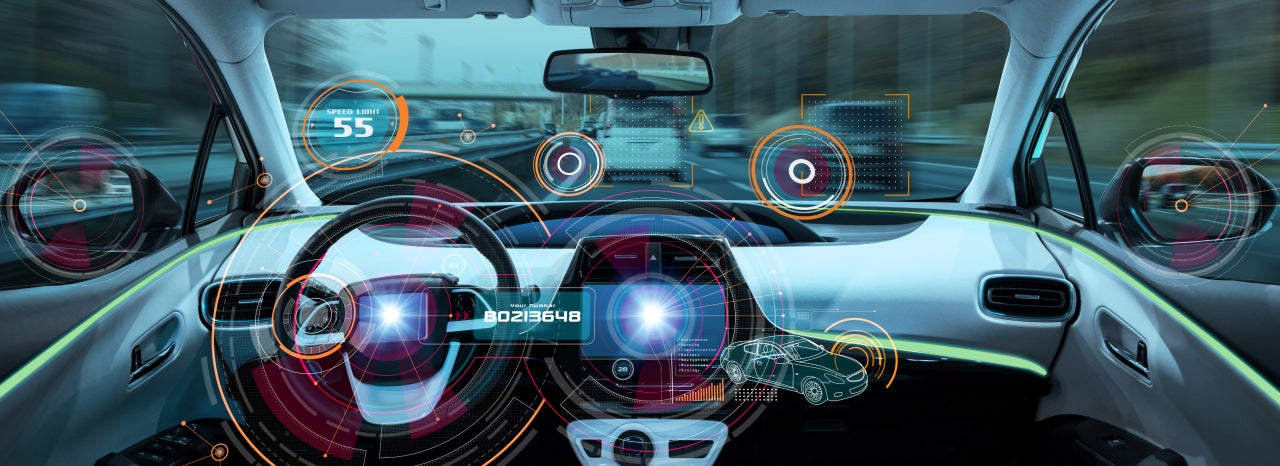
There has been a long-standing concern in the sector that automakers are losing control of the in vehicle infotainment and navigation experience. For many OEMs, this is a problem that could have far-reaching implications for consumers and manufacturers alike.
According to Ronak Amin, Product Marketing Manager for Connected Driving at HERE Technologies, a mapping, location data and related automotive services company. The in vehicle infotainment experience is set to return to the forefront. Why? Because of the potential risks for OEMs in losing that control over the experience.
“OEMs have been on a long journey to differentiate the in vehicle infotainment experience,” he explains. They are doing that for a couple of reasons: to mitigate the risk of that experience being marginalized from one vehicle or one brand to another, and to create new in-vehicle revenue opportunities that help diversify their business model. “In-vehicle navigation is core to that whole IVI experience, and not just because it’s the focal point of the driver,” says Amin. “The data generation that the OEM and the consumer both benefit from is critical as well.”

In the early 2010s, says Amin, most vehicles offered a substandard in vehicle infotainment experience at best. That was mainly because consumers were benchmarking against the operating systems and user interfaces (UI) from their mobile phones. This led to the widespread adoption of brought-in solutions using the consumer’s navigation app of choice. “That’s a convenient solution that is especially good for vehicles that don’t necessarily have the requisite hardware to do a fully embedded system,” he says. “It also helps consumers to be able to keep a consistency across different vehicles they own, or rental cars.”
But the downside is it stymies the OEM’s vision of creating an in vehicle infotainment experience to enhance their brand value and unlock new revenue potential, which becomes difficult when control does not necessarily fall under the OEM. This revenue opportunity is particularly important of late. For example, growth in electric vehicles (EVs) may also represent longer sales cycles and a threat to their spare parts sales volume – a major profit contributor for today’s OEM.
“You would assume that if there are fewer moving parts in the vehicle, that aftermarket business starts to decline, so OEMs are looking to offset that,” says Amin. “OEMs are going to try to diversify their revenue base, probably more than ever. But if you look at how many levers the OEM can actually pull, there’s not many, which makes the IVI all the more important.”
The digital cockpit concept
So, what impact is all this having on OEMs’ control of their own cockpits? The digital cockpit concept is a multi-interface ecosystem with the intention of creating a comprehensive and tailored driving experience, says Amin, putting greater emphasis on regaining developmental and UI control. “It’s dependent on having a level of system integration throughout the vehicle where everything is working harmoniously.”
Currently, not all OEMs deploy a full digital cockpit or dashboard, but many of those that are going in this direction have already taken back developmental control to provide their developers optionality and create a seamless experience. As well as multiple screens to meet the driver’s needs, it makes sense to integrate features that can be used by those in the passenger and back seats, often referred to as the digital cabin.
“You can expand the in-vehicle experience beyond the traditional driver-centric features we’re used to,” says Amin. “We’re talking about potentially bringing multimedia, gaming and entertainment into the digital cockpit as well, making that a more attractive proposition to the rest of the cabin.” Such integration would be difficult to achieve through brought-in solutions.
With most consumers discontinuing their subscription to connected navigation services once any free trials have finished, not having embedded navigation can compromise OEMs’ connected car ambitions, says Amin. “In the past, subscription rates have struggled, particularly in lower-tier segments.
In older embedded systems, navigation services quickly became outdated, requiring frequent trips to the dealership. “The attractiveness was really degrading after only a short time of ownership. If you look at today’s embedded navigation systems that are more native to the cloud, they’re able to deliver regular updates over the air, and not just to maps, but also new features and functionality, at any point of the vehicle’s lifecycle.”
There are, says Amin, “probably more tailwinds than headwinds” when it comes to trying to increase subscriptions to connectivity and navigation systems. But in terms of some of the risks to the connected car ecosystem, navigation is so core to it that, without it, OEMs, and the transportation industry more broadly, might not be able to achieve their vision. “The connected car ecosystem, or the whole C-V2X [cellular vehicle-to-everything] concept, could potentially lead to safer roads and more efficient transport, traffic and infrastructure planning. This is a big topic and not just in automotive terms.”
With global supply chains still demonstrating fragility, there are also unintended consequences in having to develop and install a new connected navigation system, according to Amin. “If you’re trying to build a solution from many suppliers, you could be putting the start of production and the whole user experience at risk. It’s timely that OEMs are starting to look at full-stack software applications for embedded navigation, rather than going to multiple suppliers and using a software development toolkit [SDK] to build in-house product. They’re going to an off-the-shelf [solution] that they can customise and layer onto. That whole reason is to keep the value chain as simplified as possible while still maintaining their brand and experience.”
This affects their operating expenses as well. “Where previously you maybe had five engineers working on an in vehicle infotainment system, you can now repurpose a few and maybe have two focused on it, because you don’t have to do the full development in-house. It also contributes to having lower integration and engineering services from multiple suppliers, versus just one supplier. There are definitely benefits there,” says Amin.
Elevating the driving experience with in vehicle infotainment
How, though, can a broader digital cockpit architecture deliver a compelling digital experience for drivers, and what are the inherent advantages? “OEMs are trying to deliver a singular experience that includes not just navigation but also the autonomy features necessary for advanced driver-assistance systems (ADAS) or highly automated driving (HAD), and other capabilities that complete the whole driving experience,” says Amin.
Embedded navigation and location intelligence can also encourage the sustainable adoption of EVs, says Amin. “Location technology plus embedded navigation systems can help alleviate some of that range-related anxiety that new [EV] drivers face. We believe that’s a key barrier to widespread EV adoption in many regions. Drivers that rely on public charging for their EVs – because they’re not able to charge at home or have to make a mid-day charge – are often faced with not knowing if the infrastructure is going to be there when they need it. It has not been fully developed in most parts of the world.”
Having a navigation system that is integrated with EV features that can maximise range boosts driver confidence in being able to get from A to B, says Amin. “It can select optimised routes for making charging stops – even with the ability to know if that charger is available and has the right type and specification for that vehicle.”
For those looking at building a navigation system or deploying one with these features embedded in a vehicle, says Amin, “the EV buyer journey would be streamlined [and] OEMs could push into e-mobility with less friction while fulfilling some of those ambitious goals that are coming from regulators and lawmakers. We need to build technology solutions to make it easier for drivers to make those decisions. That’s a really key part that tech can play – it can help OEMs move these vehicles and keep the sustainability agenda moving in the right direction.”
A modular architecture – which emphasises OEM branding while integrating an end-to-end navigation system – enables OEMs to adapt systems to changing consumer expectations while retaking control of vehicles’ cockpits. The industry is starting to talk more about software-defined vehicles (SDV), essentially computers on wheels that can be updated as easily as mobile phones. “It’s no longer about the just point of sale and providing a vehicle that quickly ages once it leaves the lot,” says Amin. “You can provide freshness, and not just through the IVI but across the vehicle, through features-as-a-service and being able to provide new functionality over the lifecycle of the vehicle.”
Commercialising opportunities and monetising data
For OEMs, this means the next stage in commercialising opportunities that already exist but have yet to be fully commercialised: leveraging vehicle data in a tanglible way and unlocking new digital touchpoints with drivers,” says Amin.
From a cost perspective, OEMs can expect this to optimise their cost, potentially being able to lower their developmental expenses and reduce complexity. “The shifting value chain from the traditional supplier relationship to more alliances and partnerships with tier ones and other tech providers is an important shift,” says Amin.
HERE Technologies is a company that works closely with its customers to deliver this.“Dating back a couple of decades, we’ve got deep experience in building maps and location intelligence,” says Amin. “We’re working with 50 of the top OEMs already in some form, and we have a lot of vehicles in our footprint: there are 150 million vehicles worldwide that run on HERE map data in total, over 34 million of which will be connected to our HERE platform in 2022. We can build a comprehensive ecosystem of not just in-vehicle solutions but also platform and data capabilities”
In addition to working directly with the OEMs, we also work with tech companies involved with OEMs as key strategic partners. “We are a high-value company in this space,” says Amin.
“We’ve been in vehicle-embedded navigation for many years, but a couple of years ago we launched our most recent offering, which is a cloud-based software-as-a-service (SaaS) type of navigation. The intention there was to build an off-the-shelf-like product for an OEM that still has a lot of optionality and is easily updatable throughout the lifecycle of the vehicle. Crucially, says Amin, this is “putting the OEM in control. We’re not taking away opportunities for OEMs to develop an experience that suites their brand across different name plates or trims levels.” This means those opportunities and data monetisation stay with the OEM as much as possible. It’s clear that taking back control can drive many benefits.


